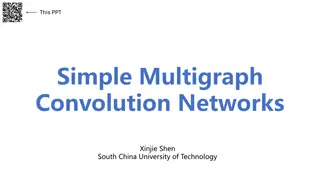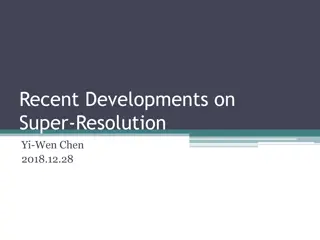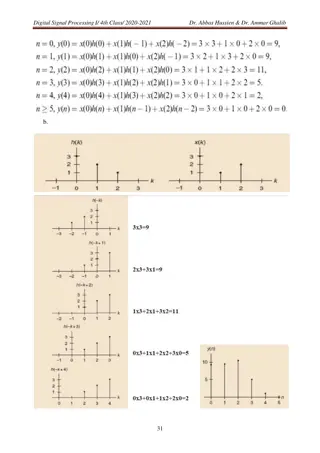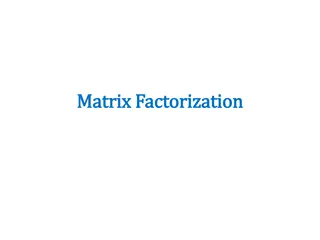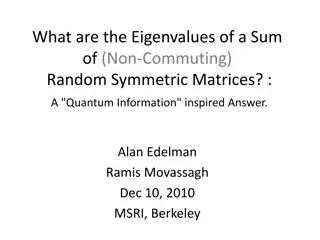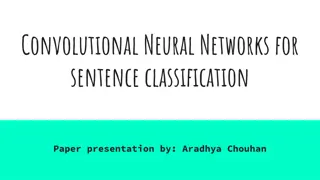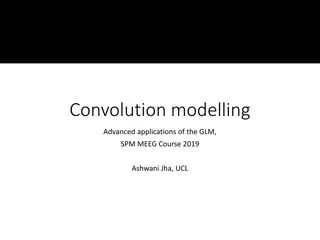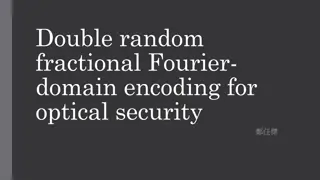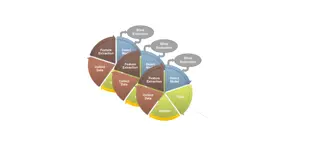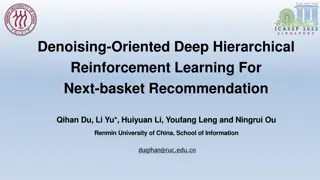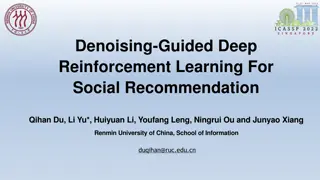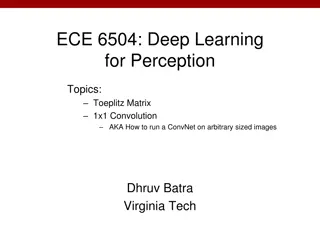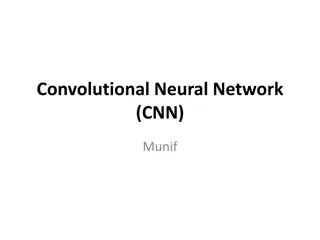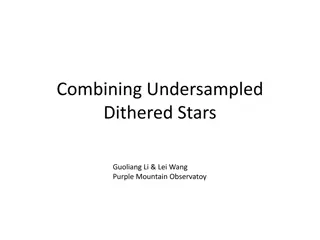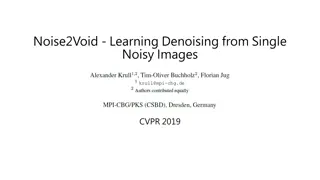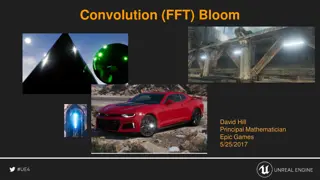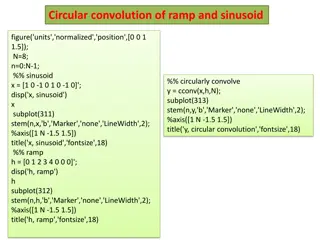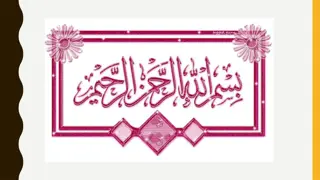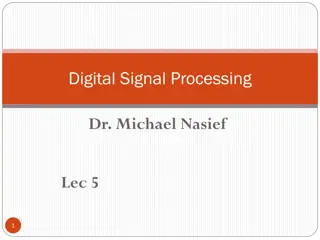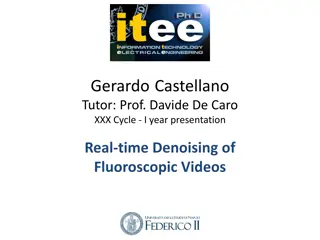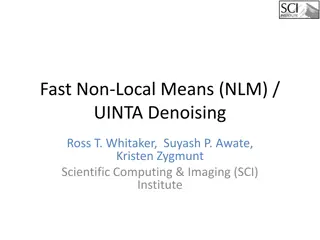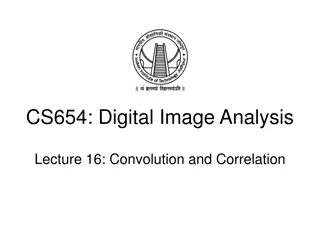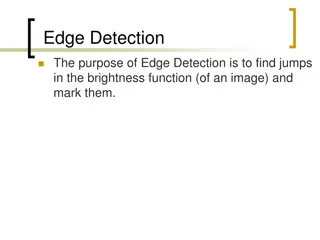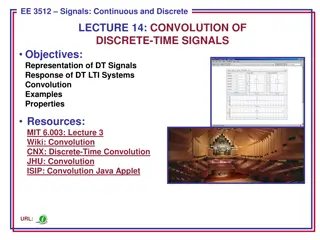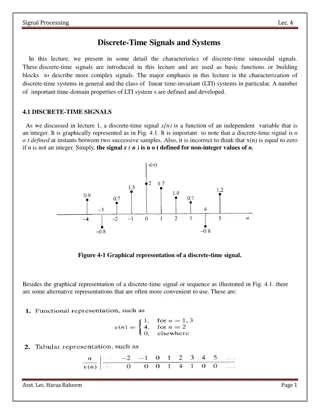Localised Adaptive Spatial-Temporal Graph Neural Network
This paper introduces the Localised Adaptive Spatial-Temporal Graph Neural Network model, focusing on the importance of spatial-temporal data modeling in graph structures. The challenges of balancing spatial and temporal dependencies for accurate inference are addressed, along with the use of distri
5 views • 19 slides
Advancements in Simple Multigraph Convolution Networks by Xinjie Shen
Explore the latest innovations in simple multigraph convolution networks presented by Xinjie Shen from South China University of Technology. The research evaluates existing methods, such as PGCN, MGCN, and MIMO-GCN, and introduces novel techniques for building credible graphs through subgraph-level
5 views • 6 slides
GPU Parallelization for 2D Convolution Optimization
Our project focuses on enhancing the efficiency of 2D convolutions by implementing parallelization with GPUs. We delve into the significance of convolutions, strategies for parallelization, challenges faced, and the outcomes achieved. Through comparing direct convolution to Fast Fourier Transform (F
0 views • 29 slides
Autoencoders: Applications and Properties
Autoencoders play a crucial role in supervised and unsupervised learning, with applications ranging from image classification to denoising and watermark removal. They compress input data into a latent space and reconstruct it to produce valuable embeddings. Autoencoders are data-specific, lossy, and
1 views • 18 slides
Recent Developments on Super-Resolution: A Comprehensive Overview
Super-resolution technology aims to reconstruct high-resolution images from low-resolution inputs, with applications in video surveillance, medical diagnosis, and remote sensing. Various convolutional neural network (CNN) models have been developed, such as SRCNN, VDSR, ESPCN, and FSRCNN, each with
0 views • 12 slides
Digital Signal Processing I 4th Class 2020-2021 by Dr. Abbas Hussien & Dr. Ammar Ghalib
This content delves into Digital Signal Processing concepts taught in the 4th class of 2020-2021 by Dr. Abbas Hussien and Dr. Ammar Ghalib. It covers topics like Table Lookup Method, Linear Convolution, Circular Convolution, practical examples, and Deconvolution techniques such as Polynomial Approac
0 views • 4 slides
Sparse Millimeter-Wave Imaging Using Compressed Sensing and Point Spread Function Calibration
A novel indoor millimeter-wave imaging system based on sparsity estimated compressed sensing and calibrated point spread function is introduced. The system utilizes a unique calibration procedure to process the point spread function acquired from measuring a suspended point scatterer. By estimating
2 views • 26 slides
Matrix Factorization for Latent Factor Recovery
Explore the concept of matrix factorization for recovering latent factors in a matrix, specifically focusing on user ratings of movies. This technique involves decomposing a matrix into multiple matrices to extract hidden patterns and relationships. The process is crucial for tasks like image denois
0 views • 50 slides
Eigenvalues in Quantum Information
Explore the eigenvalues of sums of non-commuting random symmetric matrices in the context of quantum information. Delve into the complexities of eigenvalue distributions in various scenarios, including random diagonals, orthogonal matrices, and symmetric matrix sums. Gain insights into classical and
1 views • 24 slides
Convolutional Neural Networks for Sentence Classification: A Deep Learning Approach
Deep learning models, originally designed for computer vision, have shown remarkable success in various Natural Language Processing (NLP) tasks. This paper presents a simple Convolutional Neural Network (CNN) architecture for sentence classification, utilizing word vectors from an unsupervised neura
1 views • 15 slides
Advanced Applications of Convolution Modelling in GLM and SPM MEEG Course 2019
Addressing difficulties in experimental design such as baseline correction, temporally overlapping neural responses, and systematic differences in response timings using a convolution GLM, similar to first-level fMRI analysis. The course focuses on the stop-signal task, EEG correlates of stopping a
1 views • 21 slides
Advanced Convolution Denoising Techniques for Large-Volume Seebeck Calorimeters
Cutting-edge research on convolution denoising methods for Seebeck calorimeters to reduce noise levels caused by temperature fluctuations. The study explores hardware design, mathematical principles, and examples of denoising applications, aiming to enhance measurement accuracy and stability in larg
0 views • 10 slides
Advanced Applications of GLM and SPM in M/EEG Course 2018
This course delves into utilizing Convolution GLM to address challenges such as baseline correction, overlapping neural responses, and systematic response timing differences in EEG experiments. It focuses on the stop-signal task, EEG correlates of movement stopping, and MEG data analysis. The course
0 views • 26 slides
Optical Security with Double Random Fractional Fourier Domain Encoding
Utilizing double random fractional Fourier domain encoding for optical security involves encryption and decryption methods based on the fractional Fourier transform of various orders, involving specific mathematical operations and notations. The process includes transforming the input function, encr
0 views • 13 slides
Analysis of Deep Learning Models for EEG Data Processing
This content delves into the application of deep learning models, such as Sequential Modeler, Feature Extraction, and Discriminator, for processing EEG data from the TUH EEG Corpus. The architecture involves various layers like Convolution, Max Pooling, ReLU activation, and Dropout. It explores temp
1 views • 15 slides
Denoising-Oriented Deep Hierarchical Reinforcement Learning for Next-basket Recommendation
This research paper presents a novel approach, HRL4Ba, for Next-basket Recommendation (NBR) by addressing the challenge of guiding recommendations based on historical baskets that may contain noise products. The proposed Hierarchical Reinforcement Learning framework incorporates dynamic context mode
1 views • 16 slides
Denoising-Guided Deep Reinforcement Learning for Social Recommendation
This research introduces a Denoising-Guided Deep Reinforcement Learning framework, DRL4So, for enhancing social recommendation systems. By automatically masking noise from social friends to improve recommendation performance, this framework focuses on maximizing the positive utility of social denois
0 views • 15 slides
Toeplitz Matrix 1x1 Convolution in Deep Learning
Explore the concept of Toeplitz Matrix 1x1 Convolution in deep learning for processing arbitrary-sized images. Discover how this technique enables running ConvNets on images of various dimensions efficiently, making use of matrix multiplication with Toeplitz matrices to achieve convolution. Dive int
0 views • 20 slides
Convolutional Neural Networks (CNN) in Depth
CNN, a type of neural network, comprises convolutional, subsampling, and fully connected layers achieving state-of-the-art results in tasks like handwritten digit recognition. CNN is specialized for image input data but can be tricky to train with large-scale datasets due to the complexity of replic
0 views • 22 slides
Advanced Image Processing Techniques for High-Quality Reconstruction
Cutting-edge methods in astrophotography, such as deconvolution and pixel convolution effects, are explored in this detailed presentation. These techniques offer superior image restoration compared to traditional algorithms, emphasizing the importance of addressing pixelation effects to achieve high
0 views • 9 slides
Innovative Denoising Techniques and Limitations
Examination of Noise2Void, Noise2Noise, and Traditional Denoising Models in image processing, highlighting their unique approaches and challenges. Implementations details, experiments, limitations, and comments are discussed, showcasing the potential and shortcomings of these techniques in denoising
1 views • 8 slides
Bloom Effects in Game Design
Bloom effects, such as weak scattering and convolution, enhance the visual appeal of games by simulating light scattering. They add realism and customization options to game graphics, improving the overall visual experience. Weak scattering causes subtle yet impactful effects like glare and diffract
1 views • 14 slides
Circular Convolution of Ramp and Sinusoid
Circular convolution of a ramp signal and a sinusoid, followed by convolving a rectangular pulse with itself for exploring convolution techniques. The process involves visualizing signal convolutions, understanding how zero-padding affects plotting clarity, and using convolution for denoising a piec
0 views • 4 slides
Earthquake Prediction Using Acoustic Data
Earthquakes can have devastating impacts, both in terms of financial losses and loss of life. Predicting earthquakes using seismographic acoustic data can help mitigate these impacts by enabling timely response systems. This research explores utilizing machine learning models to predict time-to-fail
0 views • 18 slides
Introduction to DSP Architectures and Real-Time Realizations in Electrical Engineering
This content delves into the world of Digital Signal Processing (DSP) architectures, specifically focusing on real-time realizations and their applications in electrical engineering. It covers the evolution of DSPs, main producers in the industry, historical milestones, the role of FPGAs in Software
0 views • 46 slides
Mahmoud El-Sakka - Computer Science Research & Teaching
Mahmoud El-Sakka is a prominent figure in the field of computer science, focusing on image denoising, compression, and prediction methods. He is known for his expertise in digital image processing and offers a course on digital image compression at the University of Western Ontario.
0 views • 9 slides
Digital Signal Processing with Dr. Michael Nasief: Understanding Convolution and Fourier Analysis
In this educational content, Dr. Michael Nasief explores key concepts in digital signal processing, focusing on topics like convolution, Fourier analysis, frequency response, and complex values. Through detailed explanations and visual aids, learners can grasp the fundamentals of finite-length seque
0 views • 19 slides
Real-time Denoising of Fluoroscopic Videos by Gerardo Castellano
Gerardo Castellano, a tutor under Prof. Davide De Caro in the XXX Cycle - I year presentation, focuses on real-time denoising of fluoroscopic videos. With a background in Electronic Engineering from the University of Napoli Federico II, Castellano's research activities primarily revolve around VLSI
0 views • 11 slides
Predicting Earthquakes with Machine Learning and Acoustic Data
Earthquakes can have devastating impacts, making it crucial to predict and prepare for them. Utilizing seismographic acoustic data and modern machine learning techniques, such as Random Forests models, can help in forecasting the time-to-failure of earthquakes. The LANL Dataset provides valuable aco
0 views • 18 slides
Fast Non-Local Means (NLM) and UINTA Denoising Techniques
Learn about Fast Non-Local Means and UINTA denoising methods for image processing within ITK framework. Explore aims including computational efficiency, noise models, and project status with code design and implementation.
0 views • 25 slides
Understanding Convolution and Correlation in Digital Image Analysis
Explore the key concepts of convolution and correlation in digital image analysis, including mask processing, interpolation techniques, and the advantages of understanding linear-shift-invariant systems. Learn about the relationship of pixels within their neighborhoods and how these operations can b
0 views • 20 slides
Understanding Edge Detection and Convolution in Image Processing
Discover the purpose of edge detection in image processing, the role of convolution in identifying edges, and the computational steps involved. Enhance your knowledge of how jumps in brightness are detected and marked in images, and learn about the weighted sum calculations that drive the process.
0 views • 67 slides
Understanding Convolution in DT LTI Systems
Explore the concept of convolution in discrete-time Linear Time-Invariant systems, where signals are represented as linear combinations of basic building blocks. Learn about unit pulses, impulse responses, and how LTI systems are characterized by their unit pulse response. Visualize the convolution
0 views • 13 slides
Understanding Convolution of Discrete-Time Signals in Pattern Recognition and Signals
Learn about the representation of DT signals, response of DT LTI systems, convolution examples, and properties in the context of pattern recognition and signals processing. Topics include exploiting superposition, time-invariance, unit pulses, LTI systems, impulse response, and visualization of conv
0 views • 14 slides
Discrete-Time Signals and Systems: Characteristics and Properties Explained
Explore the characteristics of discrete-time sinusoidal signals and the general properties of discrete-time systems, focusing on linear time-invariant systems. Learn about impulse responses, convolution sums, and key properties of convolution operators in signal processing.
0 views • 16 slides
Real-Time Exemplar-Based Face Sketch Synthesis Pipeline
Learn about a real-time exemplar-based face sketch synthesis pipeline that utilizes photo-sketch pairs and advanced algorithms for sketch denoising, including Coarse Sketch Generation and Proposed Spatial Sketch Denoising Algorithm (SSD).
0 views • 9 slides
Probabilistic Models for Denoising Diffusion - Research Explained
Explore the world of denoising diffusion probabilistic models with a detailed outline covering introduction, method, experiments, and conclusions. Learn about the training objectives, network architecture, and achieved results in image generation. Discover the potential for future research and impro
0 views • 12 slides
Deep Similarity Learning for Multimodal Medical Images
Explore how deep neural networks are utilized to learn similarity metrics for uni-modal/multi-modal medical images in the context of image registration and clinical applications. Methods such as fully connected DNNs and stacked denoising autoencoders are discussed, emphasizing the importance of effe
0 views • 19 slides
Understanding Fourier Transform and Convolution Mechanics
Explore the definitions and proofs of Fourier Transform and Convolution, unraveling the mathematics behind these fundamental concepts through detailed step-by-step explanations.
0 views • 5 slides
Properties of Z-Transform and Inverse Z-Transform Lecture Overview
Explore the properties of the Z-transform and the inverse Z-transform, covering linearity, convolution, initial value theorem, final value theorem, and more. Understand modulation, summation, and convolution in the context of signals and systems. Delve into the intricacies of the Z-transform through
0 views • 11 slides

